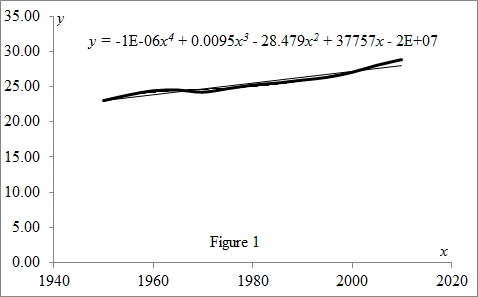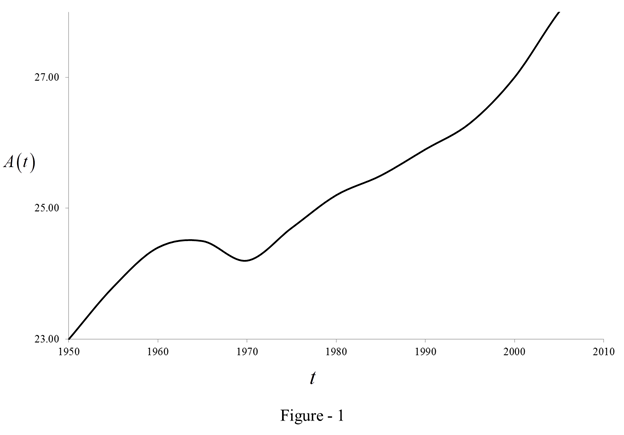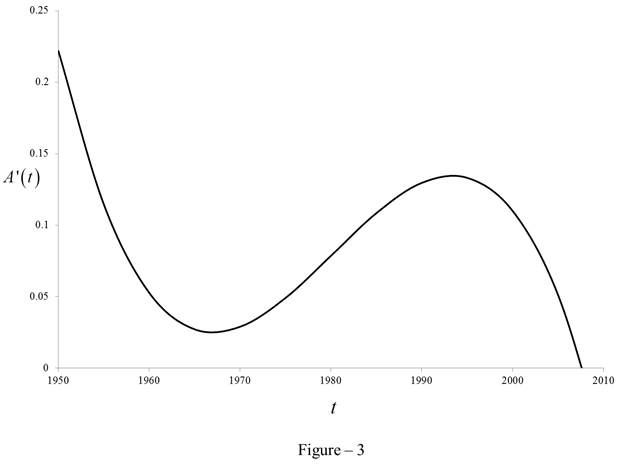
Concept explainers
The table shows how the average age of first marriage of Japanese women has varied since 1950.

(a) Use a graphing calculator or computer to model these data with a fourth-degree polynomial.
(b) Use part (a) to find a model for A′(t).
(c) Estimate the rate of change of marriage age for women in 1990.
(d) Graph the data points and the models for A and A′.
(a)
To find: To model the given data with a fourth-degree polynomial.
Answer to Problem 26E
The fourth-degree polynomial is
Explanation of Solution
Given:
The average age of first marriage of Japanese women has varied since 1950 is shown in table (1).
| 1950 | 23.00 |
| 1955 | 23.80 |
| 1960 | 24.40 |
| 1965 | 24.50 |
| 1970 | 24.20 |
| 1975 | 24.70 |
| 1980 | 25.20 |
| 1985 | 25.50 |
| 1990 | 25.90 |
| 1995 | 26.30 |
| 2000 | 27.00 |
| 2005 | 28.00 |
Calculation:
Model the given data with a fourth-degree polynomial.
Plot the graph between

Refer the figure (1).
The fourth-degree polynomial for the curve is as below.
Equate the equation (1) with equation (2).
Compare the above equation.
(b)
To find: The model for
Answer to Problem 26E
The value of
Explanation of Solution
Calculate the value of
Differentiate equation (1) with respect to
Substitute
Thus, the value of
(c)
To estimate: The rate of change of marriage age for women in 1990.
Answer to Problem 26E
The rate of change of marriage age for women in 1990 is
Explanation of Solution
Compute the rate of change of marriage age for women in 1990 using the formula below.
Substitute 1990 for t.
(d)
To sketch: The graph of data points and models for A and
Explanation of Solution
Plot the graph between

Calculate the difference between the year 1950 and 1955.
Substitute the value 5 for the expression
Similarly, calculate the value of
Tabulate the value of
| Difference | |
| 0 | 0.221834 |
| 5.0 | 0.114614 |
| 10 | 0.052734 |
| 15.0 | 0.027194 |
| 20 | 0.028994 |
| 25.0 | 0.049134 |
| 30 | 0.078614 |
| 35.0 | 0.108434 |
| 40 | 0.129594 |
| 45.0 | 0.133094 |
| 50 | 0.109934 |
| 55.0 | 0.051114 |
| 60 | -0.052366 |
Plot the graph between

Chapter 3 Solutions
Single Variable Calculus: Concepts and Contexts, Enhanced Edition
 Calculus: Early TranscendentalsCalculusISBN:9781285741550Author:James StewartPublisher:Cengage Learning
Calculus: Early TranscendentalsCalculusISBN:9781285741550Author:James StewartPublisher:Cengage Learning Thomas' Calculus (14th Edition)CalculusISBN:9780134438986Author:Joel R. Hass, Christopher E. Heil, Maurice D. WeirPublisher:PEARSON
Thomas' Calculus (14th Edition)CalculusISBN:9780134438986Author:Joel R. Hass, Christopher E. Heil, Maurice D. WeirPublisher:PEARSON Calculus: Early Transcendentals (3rd Edition)CalculusISBN:9780134763644Author:William L. Briggs, Lyle Cochran, Bernard Gillett, Eric SchulzPublisher:PEARSON
Calculus: Early Transcendentals (3rd Edition)CalculusISBN:9780134763644Author:William L. Briggs, Lyle Cochran, Bernard Gillett, Eric SchulzPublisher:PEARSON Calculus: Early TranscendentalsCalculusISBN:9781319050740Author:Jon Rogawski, Colin Adams, Robert FranzosaPublisher:W. H. Freeman
Calculus: Early TranscendentalsCalculusISBN:9781319050740Author:Jon Rogawski, Colin Adams, Robert FranzosaPublisher:W. H. Freeman
 Calculus: Early Transcendental FunctionsCalculusISBN:9781337552516Author:Ron Larson, Bruce H. EdwardsPublisher:Cengage Learning
Calculus: Early Transcendental FunctionsCalculusISBN:9781337552516Author:Ron Larson, Bruce H. EdwardsPublisher:Cengage Learning





